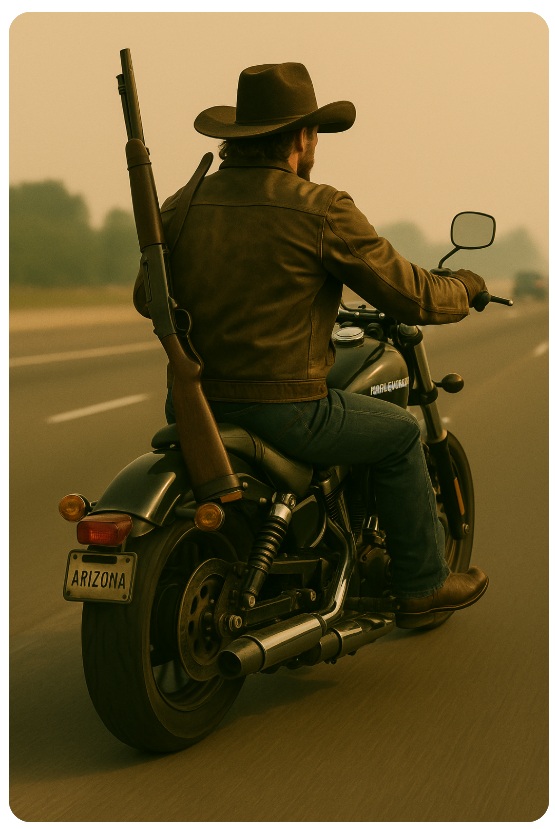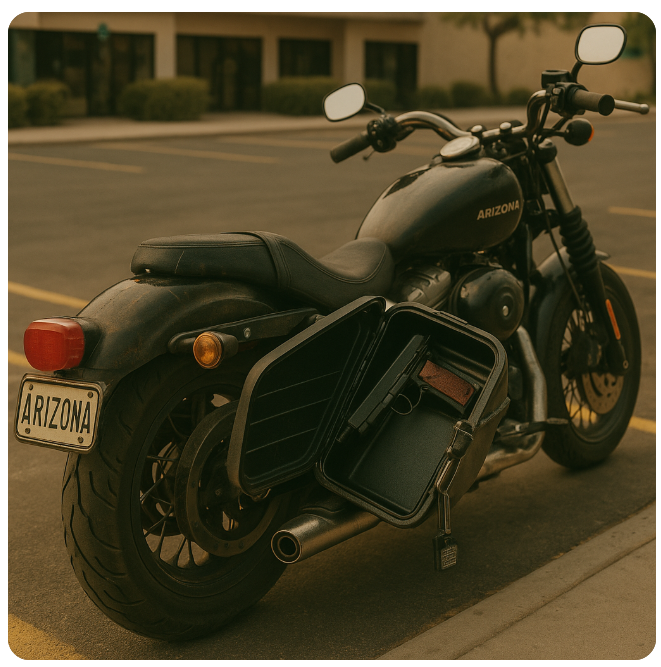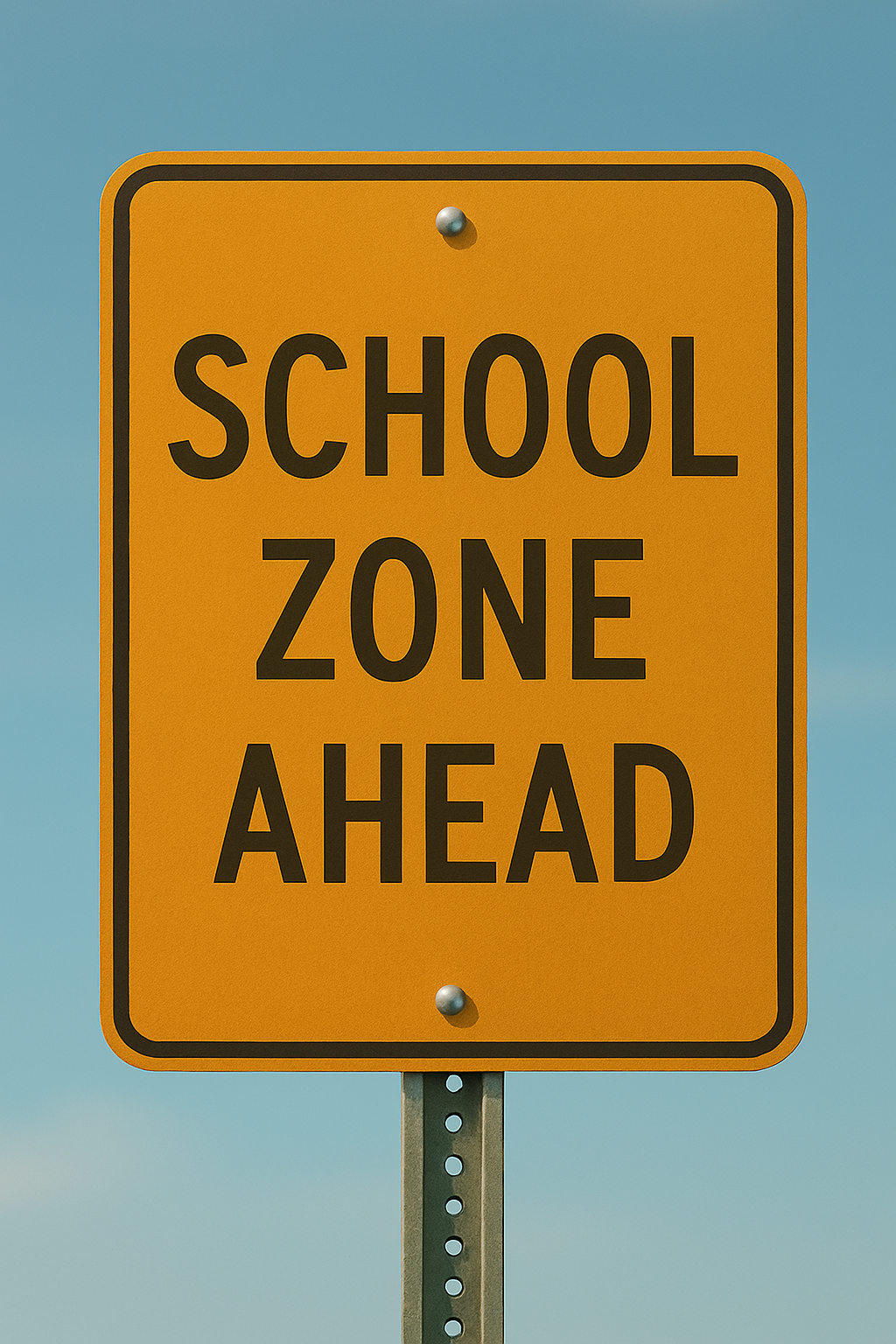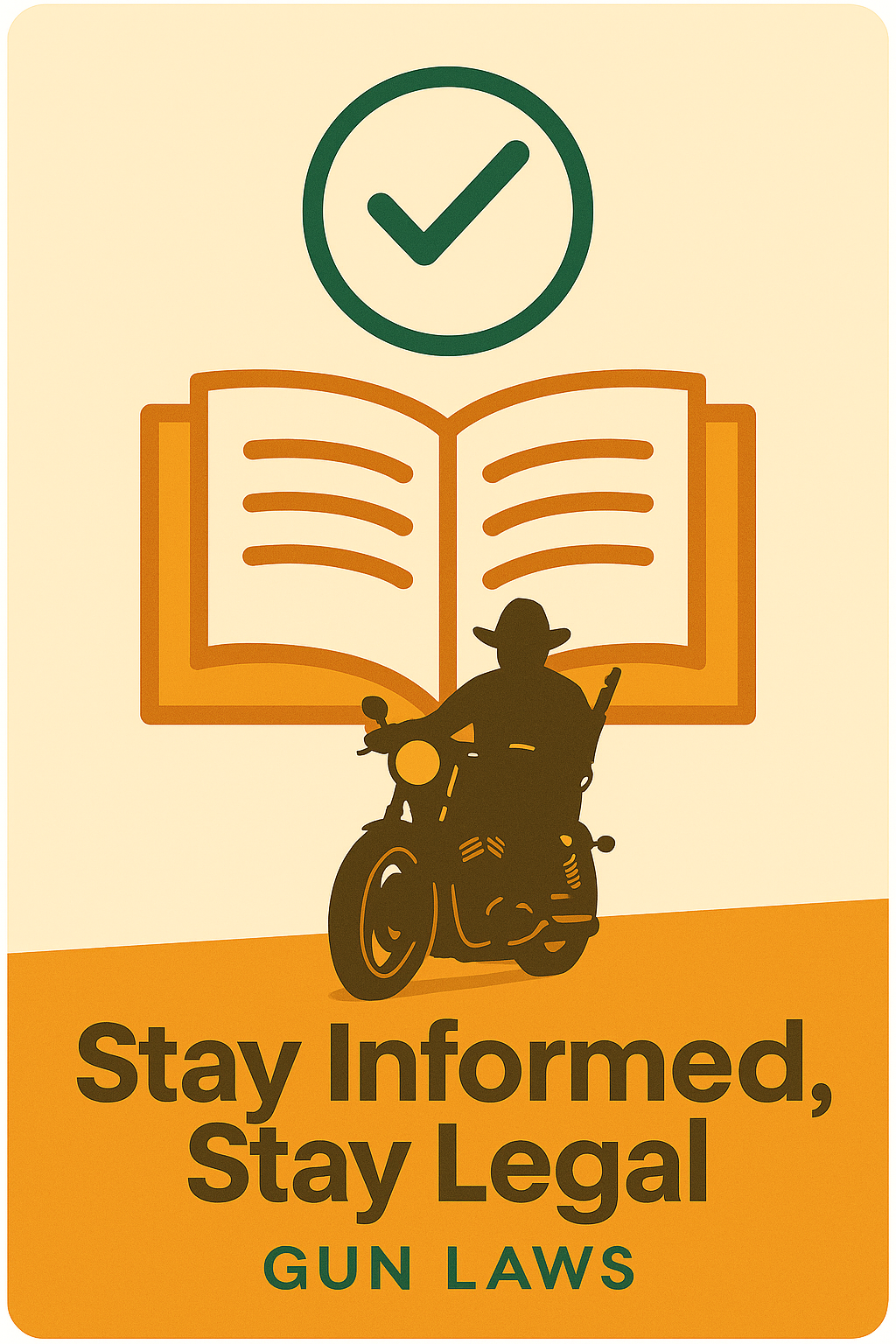
Introduction
Arizona is known for some of the strongest protections for gun owners in the country (NRA-ILA). However, laws around transporting firearms in vehicles and on motorcycles can be nuanced—especially when it comes to age limits, visibility requirements, and the distinction between carrying and storing firearms. This guide breaks it down using actual Arizona statutes, court interpretations, law enforcement guidance, and practical examples.
In Arizona, a state known for its strong support of the Second Amendment, firearm owners often take pride in both their rights and responsibilities. While many are familiar with the laws concerning firearms in standard vehicles, there is significantly less clarity when it comes to transporting firearms on motorcycles or non-enclosed motor vehicles like ATVs and UTVs. Understanding the law is essential not only for legal compliance but also for ensuring safety and responsible firearm handling.
This article provides an expanded examination of Arizona law regarding motorcycle and vehicle firearm transport—focusing specifically on A.R.S. § 12-781 (governing firearm storage) and A.R.S. § 13-3102 (defining lawful vs. unlawful carry), along with insight into related court rulings, regulatory interpretations, and best practices for secure and visible transport.
Overview of Arizona’s Gun Laws

Constitutional Carry State
Arizona is a constitutional carry state, which means law-abiding citizens may carry firearms either openly or concealed without a permit, provided they meet certain age and legal criteria. However, constitutional carry does not exempt individuals from the specific conditions imposed by transportation laws—especially those concerning minors, prohibited possessors, and distinctions between storage versus active carry.
According to Arizona law:
- Open carry is permitted for individuals 18 years or older who are not legally prohibited from possessing firearms.
- Concealed carry is legal for individuals 21 years or older without a permit.
- Arizona continues to issue permits through its Concealed Weapons Permit (CWP) system, which may be beneficial for reciprocity in other states (Arizona Attorney General’s Firearms Guide).
—————————————————————–
🎥 Video Gallery
🎬 Legal Lessons in Motion: Arizona Traffic Stop Videos
🎥 1. “I Have a Weapon”: AZ Deputy Takes Possession of a Handgun from Drivers During Traffic Stops
- Link: Watch on YouTube
- Description: This video captures a real-life traffic stop in Arizona where a driver informs the deputy about a firearm in the vehicle. The deputy then takes possession of the handgun during the stop.
🎥 2. What to Do If Police Ask About a Weapon During a Stop in Arizona?
- Link: Watch on YouTube
- Description: Attorney David Lish from Grand Canyon Law Group discusses the legal considerations and best practices for Arizona drivers when disclosing firearm possession during a traffic stop.
🎥 3. Arizona Publishes Traffic Stop Guide for Guns in Cars
- Link: Watch on YouTube
- Description: This video discusses Arizona’s initiative to educate drivers on how to handle traffic stops when carrying firearms, aiming to ensure safety and legal compliance.
—————————————————————–
How A.R.S. § 13-3102 Defines Legal and Illegal Firearm Carry
What It Says
§ 13-3102 is Arizona’s principal statute that defines the boundaries of lawful versus unlawful firearm possession and transportation. Among the prohibited activities, the law specifies the legal thresholds for age, visibility, vehicle transport, and carry location.
Notably, subsection A(2) outlines:
“A person commits misconduct involving weapons by knowingly… Carrying a deadly weapon without a permit pursuant to section 13-3112 except a pocket knife concealed on his person or within his immediate control in or on a means of transportation.”
Key Provisions Include:
- Open carry is allowed for persons 18+ if the firearm is not concealed.
- Concealed carry in a vehicle (or on a motorcycle) is only legal for 21+ without a permit.
- Transport of a firearm in any holster, scabbard, or visible case does not constitute concealed carry.
- A firearm inside a glovebox, center console, under-seat area, or saddlebags is considered concealed unless visibly displayed and meets statutory age limits.

Application to Motorcycles and Open Vehicles
For riders of motorcycles, ATVs, and similar vehicles:
- A firearm may be carried in plain view in a scabbard, sling, open mount, or external holster.
- Visibility means a reasonable person standing outside the vehicle or motorcycle should be able to readily identify the object as a firearm.
- A concealed firearm on a motorcycle (e.g., in a zipped saddlebag) is illegal without a permit unless the rider is 21 or older.
Examples of visible firearm carry:
- A rifle slung over the rider’s back in a secured and visible sling.
- A holstered pistol mounted on a belt, tank, or saddlebag flap that is not enclosed.
Unlawful concealment examples:
- A handgun zipped inside a closed saddlebag or tank pouch (under 21).
- A firearm under a rider’s jacket or vest with no outward indication.
A.R.S. § 12-781 – Firearm Storage in Vehicles and Motorcycles
A.R.S. § 12-781 reinforces the right to lawfully store firearms inside personal vehicles and motorcycles, specifically addressing workplace parking scenarios and public-access areas.
What the Law Provides
- A firearm may be stored in a locked compartment such as a glovebox, trunk, saddlebag, or lockbox on a motorcycle.
- If stored, the firearm must not be visible from outside the vehicle.
- Storage protection under this statute only applies when the vehicle is parked.
- Employers may not prohibit lawful firearm storage in privately owned vehicles parked in publicly accessible lots.
- Exception: Employers can restrict firearm possession in company-owned or leased vehicles (Littler Mendelson P.C.).

Carry vs. Storage—Don’t Confuse the Two
A firearm stored while parked under § 12-781 is not the same as a firearm actively carried during travel. Laws governing active transport are subject to § 13-3102 and related case law. For instance, storing a firearm in a locked case on a parked motorcycle is protected. But riding with that same firearm locked in the case—without proper age or permit status—could constitute unlawful concealed carry.
Gun Racks and Visible Transport in Vehicles
Gun racks remain a lawful and traditional means of transporting long guns, especially in pickup trucks and off-road vehicles. While not explicitly mentioned in statute, their use aligns with established open carry practices under Arizona law.
Legal Guidelines:
- A rifle in a rear window rack is legal for anyone 18 or older, provided they are not a prohibited possessor.
- The firearm must be readily visible from outside the vehicle.
- No requirement exists to unload the firearm, but doing so is a widely recommended safety practice.
Practical Considerations:
- Use locking racks or cable locks when possible.
- Avoid leaving firearms exposed in any unattended vehicle, regardless of how safe the area may seem. Theft can happen anywhere—and visible firearms are prime targets.
- Firearms unloaded and locked in gun racks within a vehicle should not violate federal school zone laws—which restrict firearm possession within 1,000 feet of K–12 schools unless specific exceptions apply.
Side-by-Side Comparison – Motorcycle vs. Vehicle


School Zone Restrictions
Under federal law (Gun-Free School Zone Notice-ATF P 5310.1), firearms are prohibited within 1,000 feet of K–12 schools unless:
- The individual is licensed by the state to carry (Arizona CWP counts).
- The firearm is unloaded and in a locked container.
- The vehicle is under control and parked.
Motorcyclists must be particularly cautious, as motorcycles do not have enclosed storage by default. Use a locked case and avoid stopping in school zones if unsure.
🔒 Federal Age Restriction on Handgun Purchase and Possession
Under federal law, individuals under the age of 21 are prohibited from purchasing a handgun from a federally licensed firearms dealer (FFL). This rule is established under the Gun Control Act of 1968, codified at 18 U.S.C. § 922(b)(1).
🔹 What the Law Says
- Individuals under 21 cannot purchase a handgun from an FFL.
- Individuals under 18 cannot legally possess a handgun at all, with a few limited exceptions (e.g., hunting, target practice with supervision, or military service).
🔹 Private Sales and Arizona Law
While federal law restricts handgun purchases under 21 from licensed dealers, some states allow private sales to individuals 18 and older. However, federal possession restrictions still apply, and anyone under 21 should exercise extreme caution and verify that any such transaction is compliant with both state and federal law.
Arizona law does not override this federal prohibition.
🔹 Implications for Transport
For individuals aged 18 to 20, even if Arizona allows open carry of handguns, federal law may still limit when and how they can lawfully possess a handgun. This legal gray area can become especially problematic when interacting with federal property, law enforcement, or school zones.
🔹 Arizona Law: Open Carry at 18+
Under Arizona Revised Statutes § 13-3102, open carry of a firearm—including a loaded handgun—is legal for individuals 18 years of age and older as long as the firearm is carried in plain view and the person is not otherwise prohibited from possessing a firearm.
- No permit is required for open carry.
- Open carry applies to both handguns and long guns.
- The firearm must be clearly visible if carried by someone under 21.
🔹 Concealed Carry Distinction
While open carry is allowed at 18, concealed carry without a permit is only legal for those aged 21 and over, under Arizona’s “constitutional carry” law (A.R.S. § 13-3112).
Individuals aged 19–20 may apply for a concealed weapons permit (CWP) only if they fall into certain exceptions:
If they are 19 or 20 years old and meet the military exception outlined in A.R.S. § 13-3112(E)(2), which includes:
- Current active-duty military service, or
- Proof of honorable or general discharge under honorable conditions.
✅ Summary
✔️ Yes, Arizona allows open carry of handguns starting at age 18.
❌ No, concealed carry without a permit is not allowed until age 21.
⚠️ Federal law still prohibits those under 21 from purchasing a handgun from an FFL, which creates a legal gray area for possession in some contexts.
🔹 Individuals aged 19 and 20 may apply for a concealed weapons permit only if they are active-duty military or honorably discharged, as outlined in A.R.S. § 13-3112(E)(2).
🔹 18-year-olds are not eligible to apply for a CWP under any circumstance.
A.R.S. § 13-3111 – Age-Based Requirements and Minors and Firearms
A.R.S. § 13-3111 outlines Arizona’s legal restrictions and conditions for firearm possession and use by individuals under the age of 18, including when and how minors may lawfully carry or access firearms.
Under 18:
- Generally prohibited from possessing firearms unless with adult supervision during legal hunting or shooting events.
- Cannot legally transport firearms alone
18 to 20 Years Old:
- May openly carry firearms if visible.
- Cannot conceal carry unless they possess a rare under-21 CWP.
- Can store firearms in locked compartments when parked.
21 and Older:
- May carry openly or concealed in vehicles or on motorcycles.
- No permit required for concealed carry within Arizona.

Practical Tips for Riders
- Use visible holsters or external cases mounted securely to saddlebags or frames.
- Back-mounted slings are acceptable if the firearm is not obstructed.
- Avoid ambiguous carry setups such as tank bags or zippered compartments unless legally permitted.
- Secure your firearm anytime the motorcycle is parked.
- Be mindful of city ordinances around sensitive areas, even if state law preempts them.

Final Thoughts: Stay Informed, Stay Legal
Know your age-based rights, the meaning of visibility, the distinction between storage and carry, and the impact of school zone restrictions. Whether you’re driving across town or cruising down a desert highway, being a responsible gun owner means staying alert to both safety and legal compliance.
References
- Arizona Revised Statutes § 13-3102 – Misconduct Involving Weapons
- Arizona Revised Statutes § 12-781 – Firearms in Vehicles and Motorcycles
- Arizona Revised Statutes § 13-3111 – Minors and Firearms
- Arizona Revised Statutes § 13-3112 – Concealed Weapons
- Arizona Attorney General’s Firearms Guide
- NRA-ILA Arizona Gun Laws Overview
- ATF – Federal Gun-Free School Zones Act
- Gun Control Act of 1968, codified at 18 U.S.C. § 922(b)(1)
- Littler Mendelson P.C. – Legal analysis and summaries of employment and firearm-related statutes in Arizona.
⚠️ Disclaimer: This article reflects an interpretation of current Arizona laws based on publicly available legal sources and guidance as of the date of publication. Because laws and enforcement practices can change due to new legislation, court decisions, or agency updates, readers are strongly encouraged to verify all legal information through current statutes or by consulting a qualified attorney.
It’s important to recognize that not all law enforcement officers are thoroughly trained in the finer points of Arizona firearm transportation laws or federal NFA (National Firearms Act) regulations. Routine traffic stops can sometimes escalate unnecessarily when an officer encounters legally owned items such as short-barreled rifles (SBRs), suppressors, or other NFA-regulated firearms. These encounters are often driven by unfamiliarity, not malice.
NFA-regulated firearm owners should carry copies of their registration paperwork (e.g., ATF Form 4 or Form 1) in their vehicle to help ensure a smooth interaction if a question arises.
If you are stopped and the officer appears unsure about firearm laws, it is appropriate to respectfully ask for a supervisor. Many officers—though well-intentioned—may not be firearm enthusiasts and may lack firsthand experience with the civilian process of purchasing, registering, and transporting firearms. This often results in the knowledge gap summarized by the phrase: “I don’t know what I don’t know.”
Experience, in this context, means more than basic training. It involves personally going through the steps of lawful firearm acquisition, questioning assumptions, seeking information, and continually building competence. Officers who proactively self-educate in their profession often demonstrate a greater understanding of nuanced legal issues—but not all officers receive—or even seek out—this level of training.
This knowledge gap does not excuse unlawful detention, but understanding its cause helps responsible gun owners remain calm, assertive, and professional during such encounters. Your preparedness and conduct can help protect your rights and may even educate others in the process.
—————————————————————–

Firearms 🔫 | NFAs 🧨 | Archery 🎯 | Hunting 🦅 | Accessories 🛠️ | Optics 🔭
Max Tactical Firearms, LLC is a licensed FFL and SOT dealer offering a broad range of products for beginners to expert firearms enthusiasts. With an extensive online store featuring over 40,000+ products from more than 500+ brands, you’ll find everything from firearms and archery to hunting, camping, survival gear, optics, and more. Max Tactical Firearms, LLC also specializes in NFA items, including suppressors, SBRs, and other Class III firearms, and they ship regulated orders to FFLs nationwide while also accepting transfers. Additionally, they offer custom heirloom-grade display cases and handcrafted leather goods built to last.
Note: Max Tactical Firearms, LLC ships nationwide, so you can browse the online store and place orders for shipping. If you are local, you can also contact them to schedule a pick-up, or transfer.
Questions? Need help?
Call: 623-980-3338
Email: [email protected]

